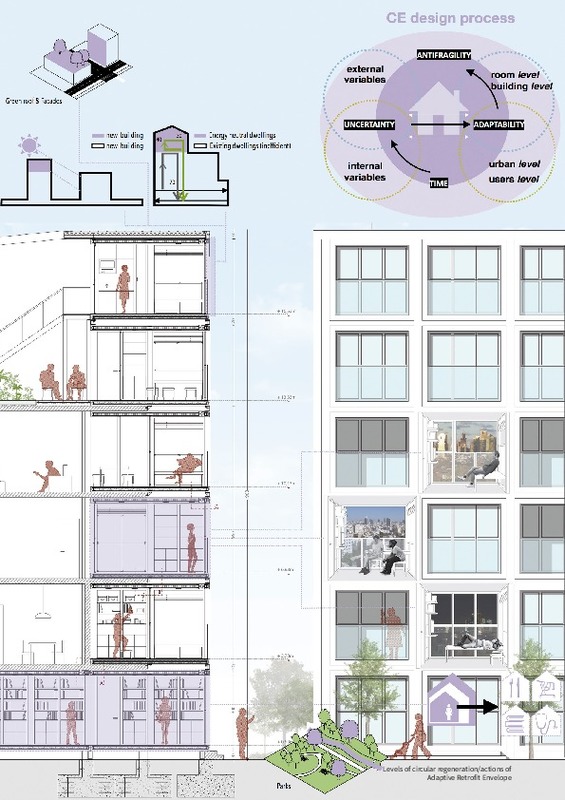Adams, K. 2016. Important Factors to Consider for Applying Circular Economy in Buildings Including a Focus on Reclamation. #BuildCircular learning hub @ EcoBuild 2016, London.
Balducci, A. 2005. Dissipative Towers. Application n. EP2010074723820100831, WO2010EP62748 20100831, International and European classification E04H9/02, Italian concession n 0001395591.
Bonara, P. 2013. Atlante del consumo di suolo. Per un progetto di città metropolitana. Il caso Bologna, Bologna: Baskerville.
[+]
Adams, K. 2016. Important Factors to Consider for Applying Circular Economy in Buildings Including a Focus on Reclamation. #BuildCircular learning hub @ EcoBuild 2016, London.
Balducci, A. 2005. Dissipative Towers. Application n. EP2010074723820100831, WO2010EP62748 20100831, International and European classification E04H9/02, Italian concession n 0001395591.
Bonara, P. 2013. Atlante del consumo di suolo. Per un progetto di città metropolitana. Il caso Bologna, Bologna: Baskerville.
Brand, S. 1994. How Buildings Learn, 12-13. United States: Penguin Books.
Cattaneo, S., Lenzi, C., & Zanelli, A. 2020. Socio-Economic Development and Regeneration of Territories, in Regeneration of the Built Environment from a Circular Economy Perspective, Springer open.
Cheshire, D. 2016. What Principles of the Circular Economy Can be Carried across to the Built Environment? #BuildCircular learning hub@ EcoBuild 2016, London.
Croxton, T. 2003. Architectural Record, August 2003, p. 147.
Darwin, C.R. 1979. On the Origin of Species, Introduced by R. Leakey. New York: Hill and Wang.
Demuzere, M., Orru, K., Heidrich, O., Olazabal, E., Geneletti, D., Orru, H., et al. 2014. 'Mitigating and adapting to climate change: Multi-functional and multi-scale assessment of green urban infrastructure'. Journal of Environmental Management, 146, 107-115. https://doi.org/10.1016/j.jenvman.2014.07.025
Densley Tingley, D., Davison, B. 2011. 'Design for deconstruction and material reus'. In Proceedings of the Institution of Civil Engineers - Energy, 164, pp.195-204. https://doi.org/10.1680/ener.2011.164.4.195
Dewey, J. 1938. Logic: the theory of inquiry. New York, Holt and Company.
Duffy, F. 1990. 'Measuring Building Performance'. Facilities, 8(5), 17-20. https://doi.org/10.1108/EUM0000000002112
Eijk, D. van. 2000. 'Eigen levens. Standaard levensloop is een historische uitzondering'. In NRC Handelsblad, n. 43.
Farrugia, S., Malcolm, D.H., Lindsay, M.C. 2013. 'An Evaluation of Flood Control and Urban Cooling Ecosystem Services Delivered by Urban Green Infrastructure'. In International Journal of Biodiversity Science, Ecosystem Services & Management, 9(2), pp. 136-45. https://doi.org/10.1080/21513732.2013.782342
Fitch, J.M. 1980. La progettazione ambientale. Analisi interdisciplinare dei sistemi di controllo dell'ambiente. Padova: Franco Muzzio.
Fusco Girard, L., & Gravagnuolo, A. 2017. 'Circular economy and cultural heritage/landscape regeneration. circular business, financing and governance models for a competitive europe'. BDC. Bollettino Del Centro Calza Bini, 17(1), 35-52. https://doi.org/10.6092/2284-4732/5472
Habraken N.J. 1998 The Structure of the Ordinary. Cambridge: MIT Press.
Kronenbourg, R. 2007. Flexible Architecture that Responds to Change. London: Laurence King Pub.
Lacy, P., Rutqvist, J. 2015. Waste to Wealth - the Circular Economy Advantage. Palgrave Macmillan, London, UK. https://doi.org/10.1057/9781137530707
Latouche, S. 2012. Per un'abbondanza frugale. Torino: Bollati Boringhieri.
Landolfo, R., Losasso, M., & Pinto, M.R. 2013. Innovazione e sostenibilità negli interventi di riquali cazione edilizia. Best practice per il retrot e la manutenzione. Firenze: Alinea.
Lester, R.K., & Piore, M.J. 2004. Innovation the missing dimension. Cambridge, Massachusetts, Harvard. https://doi.org/10.4159/9780674040106
Marini, A., Meda, A. 2009. 'Retrofitting of r/c shear wall by means of high performance jackets'. In: Engineering Structures, 31 no. 12: pp. 3059-3064. https://doi.org/10.1016/j.engstruct.2009.08.005
O'Connor, D. 2015. Every Department Does not need a Laminator! Breaking the Rules for Circular Practices. The Circular Economy in Organisations. London: University College London.
O'Rourke L. 2016 Modular Manufacturing.
Rees, W.E. 1999. 'The built environment and the ecosphere: a global perspective'. Journal of Building Research & Information, 27, 206-220. https://doi.org/10.1080/096132199369336
Riva, P., Perani, E., & Belleri, A. 2010. 'External R.C. Structural Walls for the Repair of Earthquake Damaged Buildings'. Paper presented at the Sustainable Development Strategies for Constructions in Europe and China Conference. Roma, 19-20 Aprile.
Schimidt, R., Eguchi, T., Austin, S., & Alistair, G. 2010. 'What is the meaning of Adaptability in the Building Industry?' Paper presented at 16th Inter.Conference. Bilbao: Open and Sustainable Building.
Schneider, T., & Till, J. 2005. 'Flexible housing: the means to the end'. In Arch. Research Quarterly, 9. https://doi.org/10.1017/S1359135505000199
Schön, D. 1987. Educating the Reflective Practitioner. San Francisco, California: Jossey-Bass.
Seo K.W., & Chang Sung, K. 2013. 'Interpretable Housing for Freedom of the Body: The Next Generation of Flexible Homes', Journal of Building Construction and Planning Research, 1, pp. 75-81. https://doi.org/10.4236/jbcpr.2013.13011
Taleb, N.N. 2012. Antifragile: Things That Gain From Disorder, 3-4. USA: Random House.
Tas, L. 1969. 'Sterftecijfers voor woningen'. Bouw, 13, pp. 529-534.
Terborgh, G. 1949. Dynamic Equipment Policy, New York: McGraw-Hill.
Till, J. 2009. Architecture depends. Cambridge: MIT Press.
United Nations. 2018. Population division 2018. In: Nations, U (Ed.), World Urbanization Prospects: The 2018 Revision, Online Edition, 2018. Ed. D.o.E.a.S.A, Geneva, Switzerland.
UN-Habitat. 2016. 'Urbanization and development: Emerging futures, World city report'. IEA, 2014, Technology Roadmap. Energy Efficient Building Envelopes. International Energy Agency, Paris, France.
Van Berkel, R., Fujita, T., Hashimoto, S., & Geng, Y. 2009. 'Industrial and urban symbiosis in Japan: analysis of the Eco-Town program'. Journal Environment Management, 90, pp. 1544-1556. https://doi.org/10.1016/j.jenvman.2008.11.010
WEF. 2016. Shaping the Future of Construction - a Breakthrough in Mindset and Technology [WWW document]. Retrieved from http://www3.weforum.org/docs/WEF_Shaping_the_Future_of_Construction_full_report__.pdf (Accessed 10.03.2021).
World Economic Forum. 2018. Circular Economy in Cities, Evolving the model for a sustainable urban future, Geneva Switzerland
[-]









